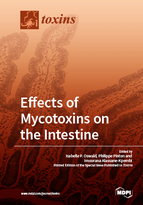Effects of Mycotoxins on the Intestine
A special issue of Toxins (ISSN 2072-6651). This special issue belongs to the section "Mycotoxins".
Deadline for manuscript submissions: closed (31 May 2018) | Viewed by 86592
Special Issue Editors
Special Issues, Collections and Topics in MDPI journals
Special Issues, Collections and Topics in MDPI journals
Special Issue Information
Dear Colleagues,
The intestine is the first target when ingesting mycotoxin-contaminated food or feed. The focus of this Special Issue of Toxins is to gather the most recent advances related to the effects of mycotoxins on the intestine. Even though the mucosa is a major functional element of the intestinal integrity, increasing evidence suggests that other constituents, such as mucus and microbiota are involved. This Special Issue will, thus, not only take into consideration the effect of mycotoxins on the intestinal tissue, but will also address the most recent advances related to effect of these contaminants on mucus and microbiota. Papers dealing with animal models, intestinal explants, as well as cellular systems, are welcome. In this context, the omics data are encouraged. Both research papers and review articles proposing novelties or overviews, respectively, are welcome.
Dr. Isabelle P. Oswald
Dr. Philippe Pinton
Dr Imourana Alassane-Kpembi
Guest Editors
Manuscript Submission Information
Manuscripts should be submitted online at www.mdpi.com by registering and logging in to this website. Once you are registered, click here to go to the submission form. Manuscripts can be submitted until the deadline. All submissions that pass pre-check are peer-reviewed. Accepted papers will be published continuously in the journal (as soon as accepted) and will be listed together on the special issue website. Research articles, review articles as well as short communications are invited. For planned papers, a title and short abstract (about 100 words) can be sent to the Editorial Office for announcement on this website.
Submitted manuscripts should not have been published previously, nor be under consideration for publication elsewhere (except conference proceedings papers). All manuscripts are thoroughly refereed through a double-blind peer-review process. A guide for authors and other relevant information for submission of manuscripts is available on the Instructions for Authors page. Toxins is an international peer-reviewed open access monthly journal published by MDPI.
Please visit the Instructions for Authors page before submitting a manuscript. The Article Processing Charge (APC) for publication in this open access journal is 2700 CHF (Swiss Francs). Submitted papers should be well formatted and use good English. Authors may use MDPI's English editing service prior to publication or during author revisions.
Keywords
-
mycotoxin
-
intestine
-
cells
-
mucus
-
microbiota
-
human
-
animals







